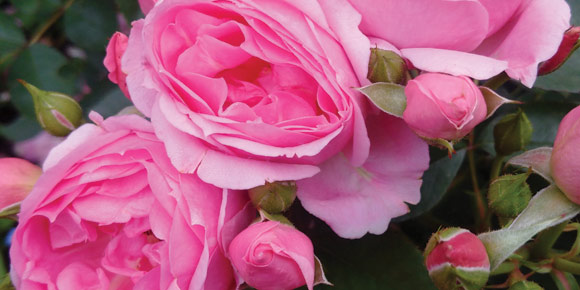Putting the garden to bed in Manitoba actually begins in mid summer when gardeners are advised to stop fertilizing woody plants and perennials such as roses. The reason? You need to give these plants time to shut down their metabolism in a timely and orderly fashion. Feeding them late into the season stimulates new growth and makes them vulnerable to frost and ultimate death. Stop fertilizing these plants after the first week of August. Conversely, pick up speed in fertilizing potted annuals which will be running out of steam by this time of the season.
To cut back perennials or not
Many tidy gardeners insist on cutting back their perennials in fall. I say, let them be. The foliage will add protection from frost and damage to root crowns as the winter becomes more bitter. The plants provide a home for overwintering ladybugs (the good, Canadian kind that know their place is in the garden, not in your home – the home invaders are those that were imported from Asia). Ladybugs eat a few tonnes of aphids each year.
The herbaceous part of the plants will break down over winter, returning nutrients to the soil and becoming easy-to-clean-up skeletons by springtime. You can actually run your lawnmower over the beds come spring for a very easy cleanup that adds organic matter and tilth to the soil. Tilth is that lightness of soil that holds moisture yet allows in oxygen. Soil with good tilth will form a loose ball if you squeeze in it your hand.
When to prune and plant tress
and shrubs
Fall is a good time to plant woody perennials, shrubs and trees. You can do this in September, so they will have a chance to establish their roots, or do it after dormancy so that they are in place to get a head start in spring.
Pruning should wait until the plant has lost its leaves and gone dormant. You don’t want to stimulate growth just when the plant should be shutting down for the winter. Choose which flowering shrubs you want to prune. If they bloom in spring, they should be pruned right after blooming so that they have time to set new buds for next year. Woody plants that bloom in fall will set their buds in the springtime so you can prune away.
Don’t forget to plant!
Fall is an ideal planting time for certain annuals. You can determine which ones these are by noticing if they will self sow each year. Delphiniums, cosmos, bachelor buttons are just a few of the varieties that you can put in just before snowfall for an early start in springtime.
What you really want to plant now is fall bulbs, so called because they need the cold of winter to perform the following year. This includes tulips, daffodils, snowdrops and crocus.
You can also try hyacinth, but plant them deeply and cover with mulch as they are a bit more tender than some of the others.
Plant bulbs in groups of five or seven, so you have a nice clump in springtime, rather than a soldier-straight line. Dig a wide hole about three times as deep as the bulb is tall and spot the bulbs around the hole every four to six inches.
The ever loving lawn
You can cut the grass about an inch tall, water well and just leave it, but if you have a weed patch you may want to do some weed mitigation in autumn.
Many experts recommend over seeding with grass seed in later summer or early fall as the best time for this job.
Water your lawn deeply. Give it a good soaking with up to six inches of water, then get rid of as many existing weeds as you can, pulling the larger ones or using a weed killer. In this case, you want to cut the existing grass very short and then dethatch, and aerate.
Add a half inch layer of compost to the lawn and rake it into the aerated lawn. Fertilize. Then add grass seed, thickly. Rake the seed in lightly. Water gently.
Don’t cut the new grass until it is about three or four inches tall to let it get well established.
What to do about fallen leaves
If your lawn is in good shape, don’t rake the leaves. Mulch them into the lawn with your lawn mower instead. They will return nutrient to the trees and the lawn.
However, some trees just put out so many leaves that this is not feasible. In this case, use that mower gain but also use the collector bag. The mulched leaves can be kept in plastic bags over winter. Puncture with a few holes to let in moisture. By springtime you will have a wonderful cache of beautiful leaf mold to feed your garden with.



